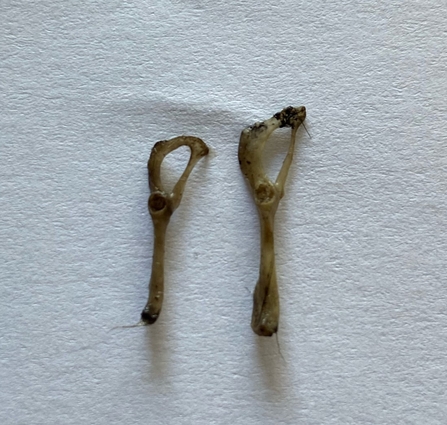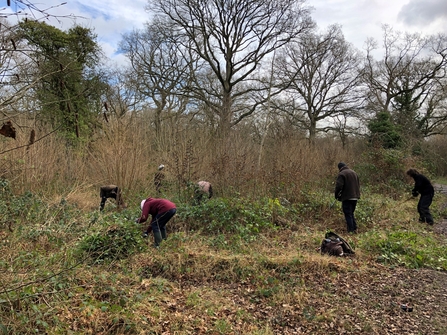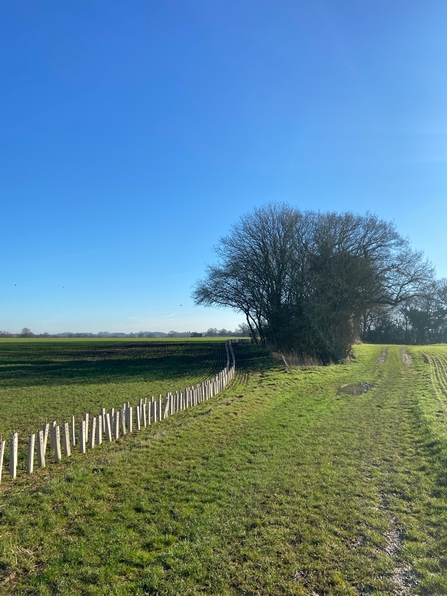Throughout the year, we have projects at each of our sites to help protect wildlife and preserve our places of wonder. Here are just a few examples of what our fantastic team, and their wonderful volunteers, have been up to in February.
Conservation Matters: How we've been helping wildlife this month
Volunteers at Wrabness planting hedges and installing rabbit-proof fences.
Connecting nature
The Big Green Internet Project is working with Essex Wildlife Trust to connect woodlands to encourage the growth of biodiversity by creating long-stretching wildlife corridors. A 6,000-acre farm was connected with hedgerows with our members’ help! Hedgerows continued to be the focus of Abberton Reservoir Nature Discovery Park’s conservation work in February, with volunteers helping to plant 200 trees in one day alone! Even better, they used sustainable ‘Grow Green’ cardboard tree guards and bamboo canes, rather than plastic.
Owl investigations

Surveying local barn owl pellets.
The Abberton team have also been researching how healthy our local barn owl residents are, by surveying their pellets. Results from six pellets revealed fourteen field voles, one house mouse, one water shrew and two commons shrew – our barn owls have been hungry hunters! This work is essential to monitor the ecosystem and indicate how healthy our land is, providing barn owls with the habitats they need to survive.
Preserving pondlands
The volunteers at Fingringhoe Wick Nature Discovery Park were busy once again at East Heath, helping to restore their pond habitat. Overgrown willow and birch saplings overshadowed this pond, and if left unchecked, would dry it out completely. In order to protect this habitat, the team removed the plants to help the pond thrive. Amphibians, water-loving plants and bird species alike will be most grateful to the team for restoring their much-loved habitat.
Similarly, invasive species were being dealt with this month at Tiptree Heath nature reserve. Pygmy weed forms a dense surface of rooted weed, damaging the natural pond habitat. To restore this pond, the team worked tirelessly on an 18-hour project to remove this weed to the pond banks, for little hiding newts and larvae to crawl back into the safety of the water, where they belong.
Butterfly benefits

The team at Belfairs managing the habitat for Heath Fritillary butterflies to enjoy.
Essex Wildlife Trust and Butterfly Conservation have been working in partnership at Belfairs Nature Discovery Centre to maintain and improve the habitats of the beautiful and nationally-rare heath fritillary butterfly, historically known as the woodman’s follower. Traditionally, this butterfly followed woodsman and coppiced woodland as it prefers open, sunny glades where its foodplant (common cow wheat) is abundant.
This project, which was forced to a stop by the pandemic, is now back in action.
If you wander through Hadleigh Great Wood at Belfairs this month, you may spot our temporary signage. You will see the areas cleared of saplings, selected stool re-coppicing and bramble and bracken cut back. The aim is to allow common cow wheat to re-grow. This is a vital food source for caterpillars, and it provides sheltered and warm refuge for the butterfly to perch, mate and lay eggs. The team are working to encourage the cow wheat growth in multiple areas of the woodland, in the hopes that this will create a connected network of havens for the butterflies to live in. These butterfly ‘crossroads’ will be achieved by removing some small trees and scrub, to open up this junction – but this is coming to a pause soon to allow for bird nesting season with no interruptions from our team!
The Belfairs team will continue to monitor the presence of heath fritillaries as the project continues, with the hopes that the habitat management work will encourage their presence. If you catch a glimpse of this delicate butterfly, let us know!
Silver linings
And finally, we have come to the end of February with weather warnings and gusty winds that have challenged not only our gardens but some of our wildlife reserves! We have seen many tree casualties in the news this past week. However, it is not all bad news. These experiences often make wildlife stronger. Like children, trees learn as they grow. If trees experience strong winds in their early development stages, as they mature, they will be able to withstand strong winds with less risk of falling. For those that topple in the tough winds, what plants can emerge now that new patches of sunlight are able to reach the forest floor? For example, a large beech tree fell victim to this week’s weather at Gernon Bushes nature reserve.
A fallen giant becomes a new habitat for woodland species.
John Spencer, Landscape Conservation Area Officer for South West Essex, discusses how local visitors reacted to the fallen trees, and how they are already making plans for new wildlife to thrive:
“Speaking to local people, it was refreshing to find they too understood the benefits of dead wood lying on the forest floor and the opportunities for nature to exploit these new habitats and create greater diversity. If left as open ground, the numerous fallow deer will browse off everything that emerges in the ground where shade once dominated. So, with assistance from the local volunteer team, Essex Wildlife Trust will try and deter them by using some of the fallen wood, as well as surrounding holly, to create a dead hedge around the new glade. Hopefully, within this quieter part of this hornbeam-oak pollard woodland, a new wildlife community is about to move in.”
We may lose a tree, but biodiversity can flourish as new species emerge in its place. Think of all the insects and little mammals that will utilise a fallen tree as shelter, a food source, or protection from predators!


